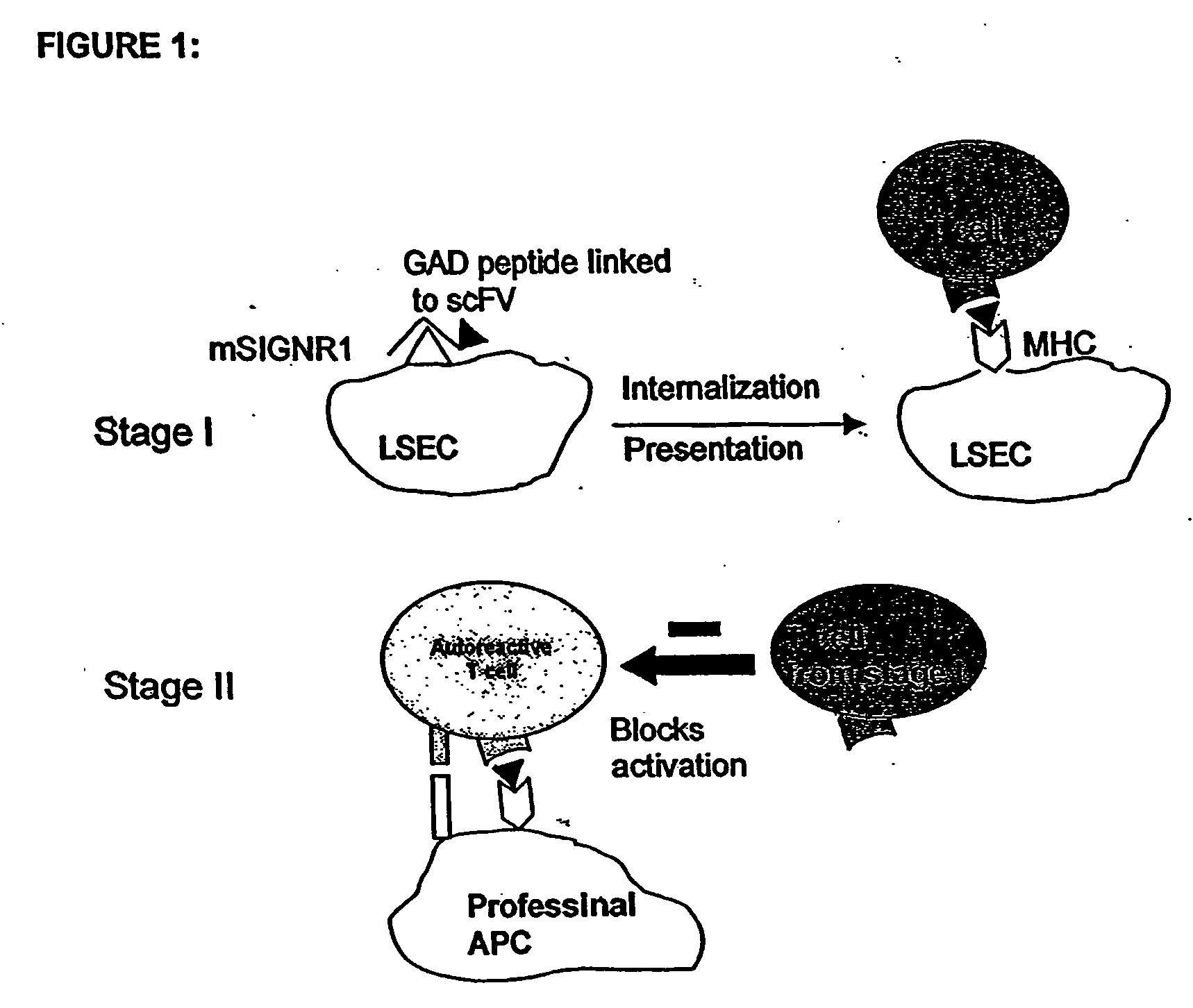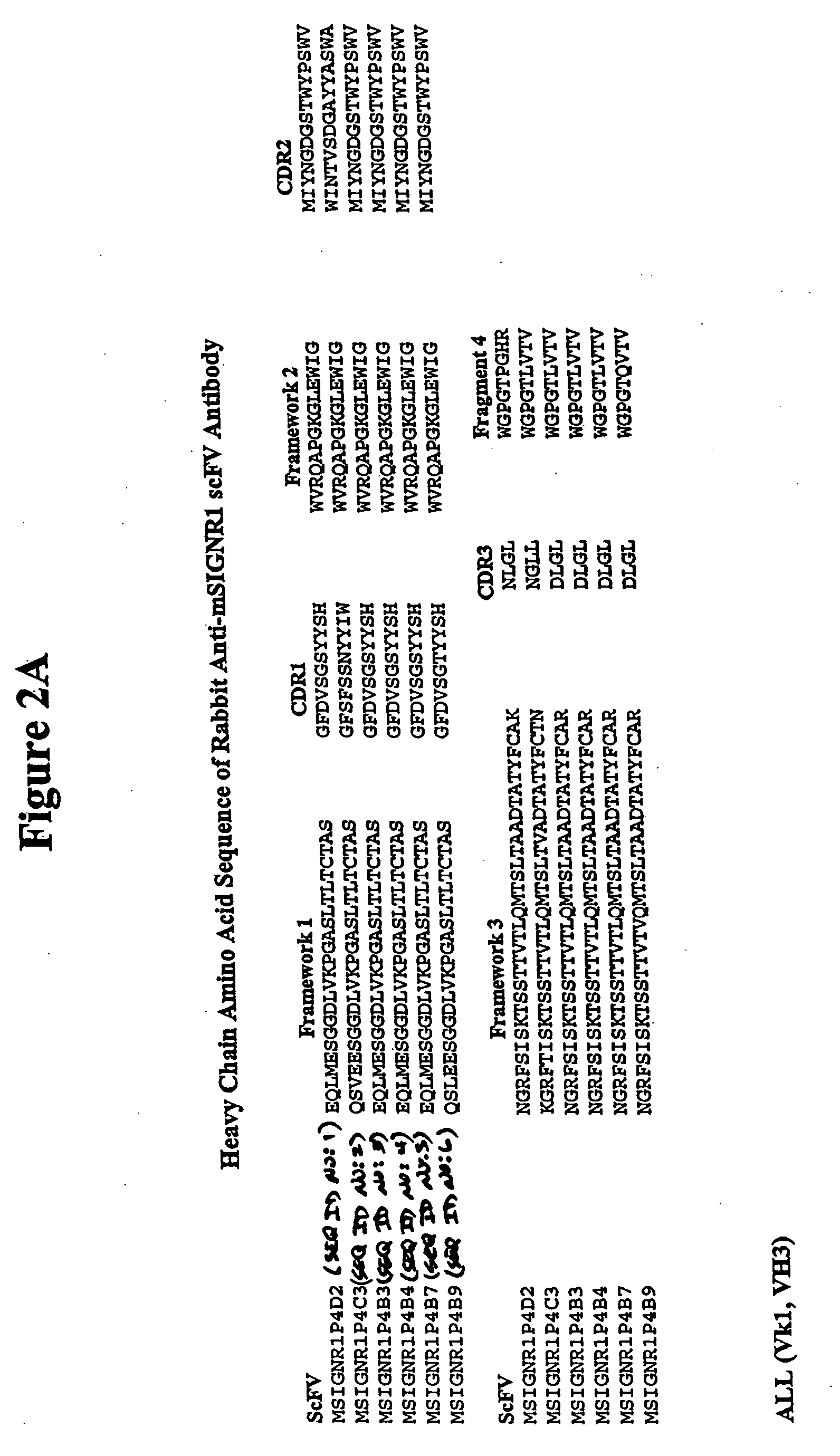Method of treating autoimmune disease by inducing antigen presentation by tolerance inducing antigen presenting cells
a technology of presenting cells and presenting cells, which is applied in the field of treating autoimmune diseases by inducing antigen presentation by tolerance inducing antigen presenting cells, can solve the problems of many tissue-specific proteins not being expressed at sufficient levels to induce tolerance, and the treatment of exogenous insulin is very debilitating, and achieves the effect of reducing the levels of dc-signr expressing cells
- Summary
- Abstract
- Description
- Claims
- Application Information
AI Technical Summary
Benefits of technology
Problems solved by technology
Method used
Image
Examples
example 1
Obtaining Anti-mSIGNR1 Antibodies
[0102] Using phage display technology, a panel of single chain antibodies (scFv) that recognize mSIGNR1 was identified. scFvs contain the variable light and heavy chain region connected by a linker. Their short length makes these antibody fragments very suitable for antigen linkage, and the capacity for binding to the receptor is preserved. Rabbits were immunized with recombinant mSIGNR1, and a scFv antibody library was constructed using the phage display vector pRL4 which is described in Published International Application No. WO 02 / 46436 A2 published on Jun. 13, 2002, the disclosure of which is incorporated herein by reference. Antibody fragments in this system are displayed on the gene III coat protein of the phage. Antibodies recognizing mSIGNR1 were isolated by 4 rounds of solid phase panning on recombinant mSIGNR1. Six different antibodies were identified. The amino acid sequences of these six antibodies are presented in FIGS. 2A and B (SEQ. I...
example 2
Identifying Anti-mSIGNR1 Antibodies that are Internalized upon Binding to the Cell Surface Receptor
Screen for Cell Lines Expressing mSIGNR1
[0103] A panel of murine macrophage cell lines (P388D1, 1-13.35, WEHI-3 and J774) are screened for expression of mSIGNR1 by RT-PCR by standard methods. Primers are designed based on the mSIGNR1 Genbank sequence and used these in RT-PCR of mouse organs. A cell line expressing mSIGNR1 on the mRNA level is identified and surface expression is confirmed by FACS analysis. 5×105 cells are incubated with 1 μg anti-mSIGNR1 antibody in PBS containing 1% BSA and 0.1% NaN3 on ice for 15 minutes, conditions that do not allow for antibody internalization. After 2 washes with PBS containing 1% BSA and 0.1% NaN3, bound anti-mSIGNR1 are detected by biotinylated anti-HA (Roche) followed by PE-conjugated streptavidin (Becton Dickenson) and cells are analyzed using FACSCalibur (Becton Dickinson, Mountain View, Calif.). Alternatively, internalization is determine...
example 3
Link GAD Peptides to the Antibody
Vector and Cloning Strategy
[0109] Following identification of the best bacterially-produced scFv, a conversion to a mammalian expression system is made. Mammalian expression allows for the appropriate secondary modifications of the peptides and endotoxin-free production. A vector (e.g., described in U.S. Pat. No. 6,355,245, the disclosure of which is incorporated herein by reference) with compatible restriction sites as shown in FIG. 3 is used. DNA from the antibody of interest in pRL4 (described above) are cut with Sfi and inserted into the Apex 3P vector containing a CMV promoter and mammalian antibody leader sequence. To insert nucleotides encoding the peptides of interest, restriction sites are chosen from the sites available (MCS=Nael, FseI, XbaI, EcoRI, PstI, EcoRV, BSABI , BstXI, NotI, BsrBI, Xho, PbvIOI, SphI, NsiI, XbaI) that are not contained within the antibody sequence. Oligonucleotides encoding peptides are synthesized by Operon with ...
PUM
| Property | Measurement | Unit |
|---|---|---|
| concentrations | aaaaa | aaaaa |
| temperature | aaaaa | aaaaa |
| transmission | aaaaa | aaaaa |
Abstract
Description
Claims
Application Information
 Login to View More
Login to View More - R&D
- Intellectual Property
- Life Sciences
- Materials
- Tech Scout
- Unparalleled Data Quality
- Higher Quality Content
- 60% Fewer Hallucinations
Browse by: Latest US Patents, China's latest patents, Technical Efficacy Thesaurus, Application Domain, Technology Topic, Popular Technical Reports.
© 2025 PatSnap. All rights reserved.Legal|Privacy policy|Modern Slavery Act Transparency Statement|Sitemap|About US| Contact US: help@patsnap.com



